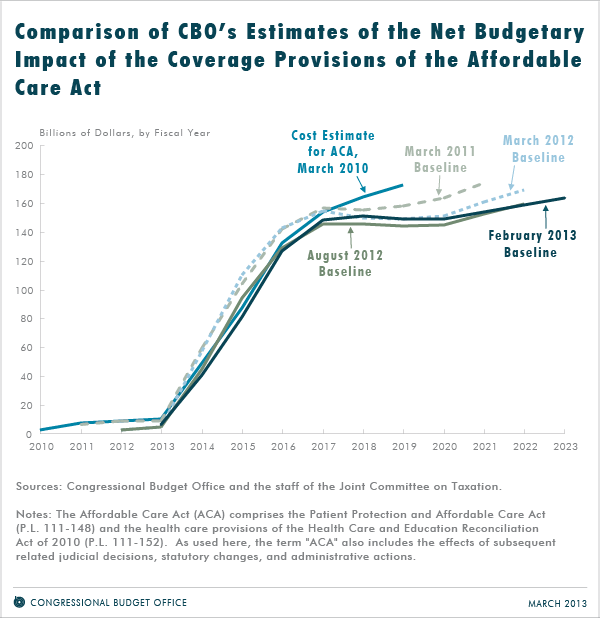The Affordable Care Act Turns Three
Tomorrow marks the third anniversary of the enactment of the Affordable Care Act. The legislation expands health insurance to about 30 million people by expanding Medicaid and creating a new health insurance exchange for individuals to purchase subsidized insurance. Those spending increases are paid for in a number of ways, including provider payment and Medicare Advantage cuts, fees on health industry companies, and upper-income tax increases.
Over the last three years, the ACA has faced many political, legal, and regulatory challenges but remains largely intact today. Here at the Bottom Line, we’ve been following the implementation of the ACA and the impact the legislation is projected to have on the federal budget. In a timely piece, the CBO has put together an analysis comparing their previous cost estimates for the ACA’s coverage provisions and finds little change in net budgetary impact of these provisions since March 2010.

Source: CBO
CBO’s analysis shows that year by year estimates have changed little. The main reason for the increase in estimated costs of the coverage provisions – now $1.329 trillion compared to $788 billion in the 2010 estimate – is the shift in the 10-year budget window. The ACA’s major coverage provisions begin next year (with expected enrollment for exchanges to be open for the first time this fall) and therefore the 10-year budget window now includes more years with this spending in effect. In addition, CBO has made a few other tweaks to account for various other changes, such as:
- Reduced marginal tax rates due to the American Taxpayer Relief Act (ATRA), which reduces the tax benefit of employer-sponsored health insurance and leads to greater enrollment in health insurance exchanges
- HHS regulations surrounding the expansion of Medicaid
- Lower expected enrollment in the early years of the coverage expansion due to exchange and Medicaid expansion readiness of states
- Healthier than expected Medicaid enrollees
- Updated income projections resulting in more subsidy-eligible taxpayers
These changes have led to a larger projected net reduction in employer coverage, from 4 million in the August 2012 baseline to 7 million in the February 2013 baseline, and an increase of 4 million in the number of uninsured. The chart below shows the projected sources of additional coverage from ACA and how they've changed since the initial estimate.
Over the last year, other changes have been made to the law such as reductions in the Prevention and Public Health Fund and the elimination of future funding for the CO-OP program to offset other legislation. Most notably, the Supreme Court’s ruling on the Medicaid expansion last summer, which allowed states to decline the expansion without losing all Medicaid funding, lowered net costs by $84 billion through 2022. The ruling has also opened a door for states to pursue greater flexibility in the administration of their Medicaid programs as they consider participating in the Medicaid expansion. Some experts and commentators believe this could serve as an impetus for additional cost containment reforms in Medicaid at both the state and federal levels.
On net, the law still reduces deficits due to various provider reductions, taxes, Medicare reforms, and other deficit reducing provisions. According to the latest estimate from July 2012, repealing the ACA would add an estimated $109 billion in deficits through 2022.
Source: CBO
Note: Positive number indicates deficit reduction.
Some savings from the ACA are already in effect, such as slowing the growth of many provider payments and Medicare Advantage cuts, and are arguably contributing to the recent slowdown in health care cost growth. However, the future of health care cost growth remains uncertain, and many of the health reforms included in the ACA do not address the issue of population aging, which will be a major driver of deficits over the next two decades. As we mark this third anniversary, policymakers should be reminded of the work left undone and renew their commitment to reform federal health spending and put it on a sustainable path. Considering that federal health spending is projected to rise from 4.9 percent of GDP to 6.4 percent in the next ten years, it will be an important task.

